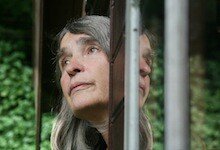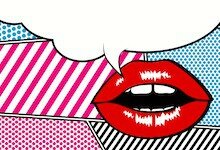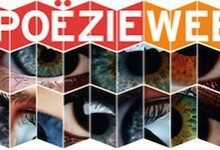Tomaž Šalamun: An Introduction
I
I met Tomaž Šalamun in the fall of 1982 in Ljubljana. There had been a poetry reading and discussion at the Slovene Writers Union in a formal, wood-paneled room lined with bookcases and busts of Slovene writers from the last century. Among those present was a dark-haired, lean-faced man about forty with glittering eyes. In one of his poems the Swedish poet Tomas Tranströmer describes driving past a locked-up church on a winter night. Inside, he imagines, is the statue of a saint, smiling like someone whose glasses have been taken away. Tomaž Šalamun looked like the saint just after he had found his glasses. Granny glasses, in fact, and a small, altogether angelic smile. It was the contrast between the eyes and the smile that made you look twice.
After the meeting there were drinks in the Writers Union bar. A nicotine haze. I had begun to wonder what it meant to be a Slovene writer. There was a woman I watched at the meeting, fleshy, tired, fairly drunk. She had a wonderful face. I asked someone who she was and was told that she had written the greatest novel in the Slovene language. Had it been translated? Into Serbian. I asked Tomaž Šalamun, who spoke English with almost no accent, what he thought of the book. It’s very good, he said. Somewhat conventional in form, a family novel about the war years. Very good. She sees, he said, and she can write. I regarded her across the room. She was about fifty-five, big-boned, with thick auburn hair and the air of a solitary. What do you do, I asked, after you have written one of the greatest novels in the Slovene language and had it translated into Serbian? Tomaž laughed. You try again. Or you sit on committees. He considered. We were conducting the conversation in the middle of all the noise in the bar, and we had to shout a bit, to lip-read. Maybe it’s sad, he said, but not while you’re writing.
Still later there were more drinks at the apartment of the American cultural attaché. Poetry in Yugoslavia: a few weeks earlier a young poet had been arrested and jailed in Belgrade. When I asked an older man in the bar about it – he was a cellist, not a writer – he said that it was really a Serbian affair. Tomaž disagreed sharply. Most of the writers seemed to share his view, but they didn’t have much information. I told them what I had heard: that the poet’s name was Djogo, that he was young, from Bosnia-Herzegovina, that his book had been approved for publication and that when it was printed it contained lines not in the approved text, some of which seemed to refer to Marshal Tito. Tito’s photograph was still to be seen displayed with what seemed genuine affection in shops and public buildings all over Yugoslavia. In Belgrade and Sarajevo I had seen high school students wearing Tito buttons. One of Djogo’s poems, turbulent, surrealistic, had ended with a line about “the one-armed beast in Liberation Square” (Tito had had an arm amputated as a result of diabetes). When the book hit the bookstores, Djogo was clapped in jail. The writers talked about the case volubly as the night wound down, analyzing it, considering responses to it. If you keep promoting the dream of the good father, someone said, somebody sooner or later is going to have a dream about the bad father and then they’re going to have to try to arrest their nightmares.
Later, as we walked through the empty downtown in the middle of the night, Tomaž continued to talk about Gojko Djogo. As it happened, Djogo spent almost a year in jail. During that time, weekly public poetry readings were organized by the Serbian Writers Union to protest the jailing. Tomaž Šalamun and other Slovene writers travelled to Belgrade to participate. It was a cool night, no moon in crisp mid-October. Ljubljana, which is the capital of the Slovene republic and has the feel of a university town, is lodged midway up the eastern foothills of the Alps, and the sky was brilliant with stars.
We also fell to speculating about the cultural attaché. Did diplomats, Tomaž wondered, have the politics of the Reagan administration? Not necessarily. The attaché had been a very large man with the build of an inside linebacker and an unexpected courtliness of manner. His wife, very handsome, sharp, slightly ravaged, looked like a young Lillian Hellman. They had seemed genuinely pleased to be pouring drinks for a voluble and disheveled bunch of writers at two in the morning. Their apartment had been littered with plastic toys, rubber balls, and cloth books with pictures of cars and steam shovels, a curiously American island in a hillside neighborhood of tall leafy trees and fin-de-siecle Austro-Hungarian flats.
They’re from Nebraska, I explained. Nebraskans are supposed to be politically conservative, and to have the traditional American virtues, neighborliness and self-reliance. They also supposedly lack guile. I wasn’t sure if he would know the word guile, but he did. In fact, he had spent two years in Iowa, where people were also supposed not to have guile. Tomaž had been interested in Iowans. They looked complete strangers right in the eye, shook their hands, and said they were glad to meet them. He imitated it for me, shaking my hand and nodding his head. “Damned glad to meet you,” he said.
I asked him about Slovenes. We were walking across a square, heading toward the river. A small baroque cathedral, illuminated, looked like an outsized scallop shell through which a thin light was passing. On the opposite bank, a shadowy hill rose, with the shadowy outline of a castle ruin on the top. Slovenes, he said, never break rules. You should see them at traffic lights. It says stop, they stop. It says go, they go.
There was a stone bridge which led to the old medieval quarter of the town. The bridge had been built in the second century by a Roman garrison. We sat down on a stone bench and began to talk about poets. He loved Rimbaud and Lautreamont, the Rimbaud of Illuminations, the young seer, more than the Rimbaud of A Season in Hell. He had spent two years in Iowa where he had come to know a good deal about American poetry-he was especially interested in Frank O’Hara and John Ashbery, in William Carlos Williams and Wallace Stevens – and he had translated some of them into Slovene. The Russian futurist Velemir Khlebnikov was important to him. Did I know Khlebnikov? I didn’t. I should, he said. Khlebnikov had been a great admirer of Whitman. We talked for a while about Pasternak, about Vasko Popa and the uses to which Serbian poetry put French surrealism. Tomaž spoke about the traditions of Slovene poetry, about Edvard Kocbek, a poet of the older generation who, as a leader of the Christian Socialists, had become Vice-President of the Slovene Republic and then came under strong attack from the Stalinists in the 1950s. And we talked about Apollinaire, quoting back and forth what we could remember of him.
A streetsweeper rolled into the square. The driver sat rigid in the cab, puffing at a pipe as he made his pass at the cathedral steps. Old women had begun to unload crates of produce in the marketplace. I had an early flight. Tomaž said he would leave copies of a couple of chapbooks for me at the hotel desk, English translations of his poems done by American poets at the Writers’ Workshop in Iowa. I was intensely curious about his poems, and not much later that morning, very groggy, my plane circling Ljubljana, the small city in the mountains, a river running through it, flashing and gleaming in the sun, I opened a book called Snow, published in 1973 by The Toothpaste Press in West Branch, Iowa. I was particularly curious about how one dealt with the fact of being a Slovene poet, what kind of relation existed between a language whose very existence suggested a fiercely conservative, tribal energy and this poet who loved the explosively experimental and visionary strains in European poetry. There were, I knew, about two million Slovenes in Yugoslavia, perhaps three hundred thirty thousand people in Ljubljana. There were over three million people in the Republic of Ireland, two and a half million in Nicaragua, but the writers of those countries wrote in world languages.
When I opened Tomaž Šalamun's book and read the first poem, ‘History’, I laughed. The solution he had found – at least in the early seventies – to any problem of cultural loneliness was the one Walt Whitman had found to his personal loneliness in Brooklyn. The reader can simulate my experience by looking at the first poem in this book. Ordering some coffee. Glancing down at the sheer limestone ridges of the Alps.
Maybe he should be put in the introduction to a book.
Possibly he should be pressed between
glass, his photo should be taken.
He should be put in formaldehyde, so children
would look at him as they do at fetuses,
proteuses, and mermaids.
II
Tomaž Šalamun was born in Zagreb, Yugoslavia, on July 4, 1941. He grew up in Koper, a town just south of Trieste on the Adriatic coast. Koper was Venetian for most of its history, Habsburg in the nineteenth century, and Italian again between the wars. Trieste and the Istrian peninsula were later divided into two zones, A and B. For centuries Istria had been Italian in its town culture, Slovene in the countryside. Šalamun’s mother's family were town Slovenes from Trieste. His father’s family came from Ptuj, an entirely Slovene town, somewhat Germanic in culture, in Styria south of Graz. His grandfather had been mayor of Ptuj. Koper, a town of about fifteen thousand in the 1940s, mostly Italian-speaking, was in Zone B. It was administered by the Yugoslavian army. The matter of Trieste was not ultimately settled until 1954. Charles Simic, who edited this book and translated many of the poems, remembers that as a small boy he vigorously chanted slogans to the effect that it was better to be dead than to live in a Yugoslavia divested of Trieste.
After 1954 Koper became a part of the Slovene republic of Yugoslavia, and in 1960 Šalamun began his studies in history and art history at the University of Ljubljana. In 1964, as editor of a literary magazine during the last days of Yugoslavian Stalinism, he spent five days in jail and came out something of a culture hero. He took an M.A. in art history in 1965, and his first book, Poker, appeared in a samizdat edition in 1966. Fresh, sometimes shocking, full of absurdist irreverence and playfulness, it is said to have inaugurated a modernist Slovene poetry in the postwar years. Its author, who has since published another twenty-four volumes of poems, was off to Italy and Paris to continue his studies in art history. He returned to Ljubljana and became assistant curator of the Moderna Galerija, the modern art museum. He married, received an important literary prize in 1969, and began to exhibit as an environmental and conceptual artist all over Yugoslavia.
The summer of 1970 brought him to New York City for an international show by performance artists at the Museum of Modern Art. He returned to Ljubljana to teach twentieth-century art at the Academy of Fine Arts for a year, and then in 1971, at the invitation of the International Writing Program at the University of Iowa, he returned to the United States, and stayed for two years. The ambience in Iowa City at that time was formed mostly by the second generation of New York School poets. Ted Berrigan and Anselm Hollo were on the faculty and among the most gifted of the graduate students were Bob Perelman and Barrett Watten, who later moved to San Francisco and became influential figures in the emergence of the so-called language poetries.
It was a congenial time, and the two American chapbooks Turbines (1973) and Snow (1974) are the result of Šalamun’s collaborations with the Iowa poets. By the time they were published, he had returned to Ljubljana, where he worked at odd jobs, translated William Carlos Williams and Apollinaire, Balzac and Simone de Beauvoir, divorced, taught primary school in a village, and worked as a salesman while continuing to write his poems. In 1979 he remarried and received a grant that allowed him to travel to Mexico, where he lived during 1979 and 1980. Šalamun returned to Ljubljana in 1981. The pace of the writing in the 1980s has slowed and the vision is noticeably darker. Over the years his poems have been translated into Serbo-Croatian, German, Polish, and Italian. This volume will introduce him for the first time to a wide English-speaking audience.
Šalamun belongs to the generation of Eastern European poets – it includes Joseph Brodsky of Russia and Adam Zagajewski of Polandwho came of age in the 1960s. They grew up not with the searing experience of war and its aftermath that has marked the poetry of the older generation (Zbigniew Herbert in Poland, Miroslav Holub in Czechoslovakia, Vasko Popa in Yugoslavia), but in the postwar years, when the pinched material circumstances of economic recovery and the pervasive intellectual dishonesty of Stalinism were a kind of normality, the world as given.
Herbert, Holub, and Popa – very different poets – seem at least in translation to have a good deal in common: their irony, their desire to talk about violence and suffering obliquely but plainly, without heroics. They have the same slightly uneasy relation to the intellectual fireworks and moral passions of their immediate predecessors, the generations of Brecht and Milosz and Camus, and to the flash and elegance of high modernism. They seem especially distrustful of the potential for destruction in all large-spirited and careless gestures. When the muse whispered in their ears, Trust your heart, trust the shapeliness of imagination, make a teacher of your strangest desires, they seem to have patted her gently and put her to bed like a child or a handicapped relation, and then gone back to work at the kitchen table. And they have seen to it that their poetry is light on cultural baggage. It is part of their power that all of this conscious limitation of means seems moral. It seems based on a desire to mime the unglamorous, undefended rituals of common life. Perhaps the best term for this relation of the artist to ordinary social routine is, not accidentally, solidarity.
By contrast, the younger generation are more impatient than their elders, and more exuberant. They are individualist rather than democratic, and they tend particularly to resent the politicization of all aspects of life. The novels of Milan Kundera also speak to this theme, as do the essays of the Hungarian novelist George Konrad. His Antipolitics calls for an effort to push back the frontiers of the political in order to give breathing room to personal, and merely social, life.(1) (That some Western European and American artists have, at the same time, made it a project of postmodernism to demonstrate that in consumer societies the personal is a complete illusion fabricated by late-twentieth-century capitalism, and that poets need to create a language that will filter this illusory ‘I’ from the clear water of linguistic play, is one of the peculiar twists in cold-war aesthetics.)
In any case, the political condition which for the older generation marked a change, a narrowing of possibilities, seem to have been for the younger generation part of the atmosphere of childhood, so they experienced it as not so much a matter of culture, but a matter of nature. It belonged to the wearying, bullying repetitions of all social regimentation, in short, whatever it is they tell you in school to get you to sit still and parrot their idea of the right answers. Joseph Brodsky, in his autobiographical essay “Less Than One” gets the tone.(2) He is recalling his childhood:
All that had very little to do with Lenin, whom, I suppose, I began to despise even when I was in the first grade-not so much because of his political philosophy or practice, about which at the age of seven I knew very little, but because of his omnipresent images which plagued almost every textbook, every class wall, postage stamps, money, and whatnot, depicting the man at various ages and stages of his life. There was baby Lenin looking like a cherub in his blond curls. Then Lenin in his twenties and thirties, bald and upright, with that meaningless expression on his face which could be mistaken for anything, preferably a sense of purpose . . .
I think that coming to ignore those pictures was my first lesson in switching off, my first attempt at estrangement. There were more to follow; in fact, the rest of my life can be viewed as a non-stop avoidance of its more importunate aspects. I must say, I went quite far in that direction; perhaps too far. Anything that bore a suggestion of repetitiveness became compromised and subject to removal. That included phrases, trees, certain types of people, sometimes even physical pain; it affected many of my relationships. In a way, I am grateful to Lenin. Whatever there was in plenitude I immediately regarded as some sort of propaganda.“The real history of consciousness,” Brodsky writes, “starts off with one’s first lie.” Splitting the self off from the tribe, giving it air to breathe and freedom to breathe in, is also a theme in Adam Zagajewski’s work. Asked to speak about the freedom to write at a 1987 PEN conference in New York, Zagajewski told his audience that the freedom to write was an important but external issue, that the real issue was, always, the freedom in writing. In his poems that imaginative space is often associated with solitude, and it comes to him as a kind of blessing, but, like Brodsky’s practice of estrangement, it seems at first alien. ‘Three Voices’ does not represent Zagajewski’s imaginative power, but it does express the attitude:
Elsewhere, as in ‘A Warsaw Gathering’, Zagajewski simply records his weariness with the language of political life:
The cloud of dusk gathers in the room.
The shadows of night are growing, tamed desire.
On the radio, Mahler’s Song of the Earth.
Outside the window, blackbirds whistle, carefree and loud.
And I can hear the soft rustling
Of my blood (as if snow were sliding down mountains).
These three voices, these three alien voices,
are speaking to me but they don’t
demand anything, they make no promise.
In the background, somewhere
in the meadow, the cortege of night,
full of hollow whispers, forms
and reforms, trying to get in order.
(Is it a procession of shadows staggering
across Red Square?) (3)
Ladies, gentlemen, boys, girls, the province,
the village, decent ones, penitents,
old ones, newcomers, Catholics, converts,
the left, the right, the thumb, lightning . . .
This is not, to borrow a distinction from Octavio Paz, a poetics of revolution, or even of revolt. The issue isn’t justice. It has no millenarian program; it is oppressed by the language of a millenarian program. And so it has the quality of inchoate rebellion, rebellion without a program. It begins in a negation that is also an act of self-liberation, and its future is open-ended, even if, as in Brodsky’s case, the idea of open vistas makes one glum. It is this tradition, or this historical moment in European poetry, to which Tomaž Šalamun, with his love of the poetics of rebellion, belongs.
‘Tea’ is one of the earlier of Šalamun’s poems in this volume. It was published in Poker, and it takes up the same theme in another idiom, rapid, playful, absurdist:
A gloss, though glosses can be tiresome. Catalina was the Roman traitor, famous until recently because he was denounced by Cicero in an oration favored by compilers of elementary Latin texts. The Beffroi is a tower in Bruges. Memling was a fourteenth-century painter; the drowning is imaginary. Christine is presumably an acquaintance of the poet. Marino Marini was an Italian modernist sculptor, whose horses do in fact resemble horses, whatever Mr. Content’s opinion. His philistine views begin to separate the poet from his own social person, the one who visits art museums and knows what tea is, in just the way that his dreaminess had separated him from his knapsack. He has begun to be Catalina, traitor to his tribe. (Most of Šalamun's poems do not lend themselves this easily to an anecdotal accounting. ‘Krakow’ does. It simply records the speech of a Polish woman who is more or less another M. Content. But behind ‘Peace to the people of this earth’, for example, I think there lies a very early memory of the armistice in Koper, but you have to live with the poem awhile to glimpse it.)
tea knows precisely why it is tea
it has no desire to be Catalina
here he comes again that ancient one
how I used to sit in Bruges
in my brown gabardine suit
and eat something resembling calamari
and my friend Sicco van Albada
son of the redheaded Jewess my father’s friend
how he used to try to persuade me
incessantly go back go back to the Beffroi
because I left my knapsack there
while staring at the Beguine sisters
at the way they looked on the road
at the swans at the drowning of Memling Gruuthuus
at Christine interpreting the legend of St. Ursula
then all of a sudden a Mr. Content
Belgian gynecologist tells me
I used to know Marini personally what a failure
do you call that a horse
and for the first time there was
this incredible creak in my lining
‘Tea’ is a young man’s poem, sweet, deft, and funny. It is another account of the process of estrangement. ‘Proverbs’, which looks like a political poem, really does the same thing:
I’m not sure how much the self-mythologizing in the early poems is meant to be political, to play off the cult of personality: every man his own Lenin. The political current is certainly there in ‘Dead Men’ which is a spell against social torpor, and in his parodic reference to “the panŠalamunian religion” as “a terribly democratic peoples’ institution.” Some of it is just cheekiness and high spirits, and in this it resembles Walt Whitman. Not only because of the self-mythology, but because of its cheerfully, pointedly unfounded confidence in the power of imagination. One of Whitman’s poems resembles ‘Proverbs’. In ‘Lo, What Fort Is Beseiged’ Whitman asks if there isn’t a fort somewhere out on the frontier that is in trouble. Don’t worry, he says. I’m sending reinforcements, the deadliest that ever fired gun. It is Blakean. The manacles are mind-forged, so take them off.
1. Tomaž Šalamun made the Party blink, tamed it dismantled it
and reconstituted it.
2. Tomaž Šalamun said, Russians Get Out! and they did.
3. Tomaž Šalamun sleeps in the forest.
But the poems acquire another kind of power when Salamun intensifies the paradoxical relation between imagination and the ordinary world. Then the vision gets darker, as in ‘Folk Song’:
In some of the later poems the sense of estrangement is fiercer yet. ‘Man with the Golden Eye’ belongs to a very powerful group that was written in Mexico around 1980. Often, in the recent poems, the persons addressed, the objects of desire, are spoken to in a tone of impatience or challenge, as if by provoking his desire they had become agents of the other world, but were unconscious of their power, had to be awakened to it, or as if the poet were now in the other place speaking back into this one with something like bitter urgency:
Every true poet is a monster.
He destroys people and their speech
His singing elevates a technique that wipes out
the earth so we are not eaten by worms.
The drunk sells his coat. The thief sells his mother.
Only the poet sells his soul to separate it
from the body that he loves.
And here, I think, is a poetics not of rebellion but of quest. Šalamun’s tradition has been the disruptive, visionary side of European experimental art, Rimbaud, Lautreamont, the German expressionists, the French surrealists, the Russian futurists, the tradition in which poetry is an instrument for glimpsing a supreme reality, and for which all art is, finally, the scattered bits and pieces of that larger vision.
Yesterday I saw the feathers of Montezuma
and how he longed for his ruin, for some foreign
god to drink up his soul. The Empire is eternal.
Eternal are the mirrors. The water evaporates,
only the gaze remains. Who hoards it up?
A chariot with a golden shaft –
I’m not that yellow fruit.
I’m not that mob staggering from the Coronation.
I ate the ticket to the Anthropological Museum
while I spoke to a tourist,
while I kept looking at you.
This accounts for Šalamun’s eclecticism, for the sense of improvisation in his poems, the surrealist lists, the New York School fast jottings of what’s going on at the moment, the disjunctions, and sense of play. They are tactics to set the centrifuge spinning, to start thedervish dance, in which some breakthrough might occur. ‘Drums’ is an early example:
In his early work, I have been told, Šalamun, influenced by Velemir Khlebnikov, uses puns, neologisms, and various lexical and syntactical outrages to turn the Slovene language inside out. None of this work has been translated, because it is untranslatable. It is interesting to think that Šalamun probably first came to Whitman through Khlebnikov. Americans are not apt to think of the Whitman absorbed – circa 1885-1890, Rilke’s youth – by a generation of European symbolists who saw him not as the realist and vernacular poet who descends to us through Williams, but as the poet of visionary recitals, of mysterious apprehensions of death, as a poet for whom the first claim to the other world is the claiming of one’s own body. One understands Šalamun better, I think, by seeing Khlebnikov respond to the Russian Revolution through the medium of ‘Song of Myself’:
I am the people’s point of view, a cow,
the tropical wind, I sleep under the surface.
I am the aristocratic carnivore, I eat form.
I drum on the cooks’ white caps . . .
In the same way, Šalamun’s use of American poetics looks familiar to us but has somewhat different intentions. It is one thing to have the Whitman descended through Williams to Frank O’Hara who, having moved from Worcester, Massachusetts, via Cambridge to the edges of the brilliant, rowdy art scene in Manhattan, could write in the last line of a poem, “and here I am/ the center of all beauty,” pledging himself to art and freedom and the playfulness of art; and it is another to inhabit a Whitman out of Khlebnikov and to stand in the middle of Ljubljana, or to be a young Slovene reading O’Hara and Plotinus and Tibetan Buddhist texts in the middle of Iowa City, or later Queretaro under the tutelage of Cesar Vallejo and the gnostics, and to try to leap past art by coming to the center of one’s own imagination and claim that space with all its monsters and demons as the ground of freedom.
Russia has granted freedom to thousands and thousands.
It was really a terrific thing to do,
People will never forget it.
But what I did was take off my shirt
And all of those shiny skyscrapers the strands of my hair
Every pore
In the city of my body
Broke out their banners and flags (4)
The translations gathered here have two sources: the work done in 1970-1971 by the poets in Iowa City in collaboration with Tomaž Šalamun; and the recent ones by Charles Simic, who worked with Serbian translations of the Slovene originals and then consulted with the author. The earlier translations, especially those of Anselm Hollo, have, appropriately, a raffish and anarchic spirit. The later ones by Simic feel more meticulous, and indeed the poems have changed. They cast denser shadows. It is a good thing to have all of this work in English. Some of it is very funny and graceful. All of it has provocation and imaginative intensity and aesthetic risk.
First published as the introduction of The selected Poems of Tomaž Šalamun. Ecco’s Modern European Poetry series, 1988.
Notes:
1) George Konrad, Antipolitics. Tr. Richard Allen, Harcourt Brace Jovanovich, 1984.
2) Joseph Brodsky, Selected Essays. Farrar, Straus & Giroux, 1986.
3) Adam Zagajewski, Tremor. Tr. Renata Gorczynski, Farrar, Straus & Giroux, 1985.
4) Velemir Khlebnikov, The King of Time: Selected Writings of the Futurian. Tr. Paul Schmidt, ed. Charlotte Douglas, Harvard University Press, 1985.








